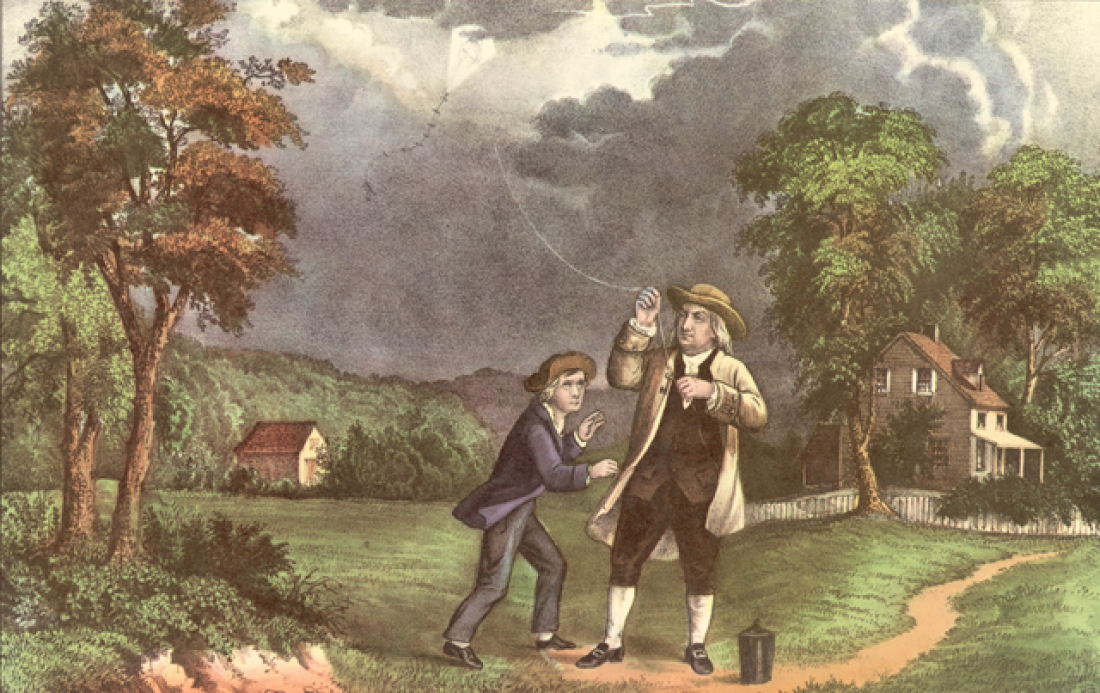Fact of the day #8: June 15 1752: Benjamin Franklin's wildly dangerous kite experiment
On June 15, on a stormy Philadelphia night, Franklin and his son sent a kite, a wire, and a key aloft into the storm - or so the story goes.

Today, our picture of the moment mostly comes from a print by Currier and Ives, done over a century later in 1876. In an open field, with a farmhouse in the background, Franklin and his young son William stand hunched against the rain as lightning strikes a kite barely ten feet above their heads. It's a dramatic scene, but it's definitely not how the experiment happened - if it ever really happened at all.
William Franklin was at least twenty-one at the time, for one thing, so at least Franklin wasn't actually guilty of the casual child endangerment depicted in Currier and Ives. And the pair weren't braving the storm in an open field; Franklin later wrote that he had stood underneath a shed roof, to keep himself and the lower end of the kite string dry during the experiment. Of course, a shed roof would have offered no real protection in the event of a lightning strike, especially if it hit Franklin or the kite he was holding.
So what actually happened?
It all started with a letter. In 1750, Franklin wrote to his friend and scientific colleague Peter Collinson, who lived in London. He told Collinson about his latest brilliant scientific idea: a lightning rod. By sticking a 30-foot metal rod into the air during a storm, Franklin suggested, you could attract a bolt of lightning and then divert the energy into a Leyden Jar, an apparatus for storing an electric charge.
Letters between scientists weren't really private correspondence in those days. A letter about a new experiment or theory tended to get passed around the scientific community, or copied and sent to colleagues. By the summer of 1752, Franklin's letter had made it to Paris, where it had electrified the scientific community there thanks to French physicist Thomas Dalibard's translation. And in fact, Dalibard tried out Franklin's lightning rod before Franklin himself could do it, on May 10, 1752.
A second French scientist, recorded only as M. Delor, replicated the experiment a week later. Franklin's lightning rod was a success, but he'd still never seen it in action - and he hadn't yet heard of its success. But by June 1752, he believed he had found an easier, more cost-effective way to set up the experiment: rather than building a tall metal spike, he could just fly a kite with a wire and a key attached. What could possibly go wrong?
In reporting his experiment to The Pennsylvania Gazette several months later, Franklin wrote,
"As soon as any of the Thunder Clouds come over the Kite, the pointed Wire will draw the Electric Fire from them, and the Kite, with all the Twine, will be electrified, and the loose Filaments of the Twine will stand out every Way, and be attracted by an approaching Finger. And when the Rain has wet the Kite and Twine, so that it can conduct the Electric Fire freely, you will find it stream out plentifully from the Key on the Approach of your Knuckle. At this Key the Phial may be charg’d; and from Electric Fire thus obtain’d, Spirits may be kindled, and all the other Electric Experiments be perform’d, which are usually done by the Help of a rubbed Glass Globe or Tube; and thereby the Sameness of the Electric Matter with that of Lightning compleatly demonstrated."
The problem, of course, is that if the key had been charged by an actual lightning strike, touching it would probably have zapped Franklin with a fatal shock, and the course of American history would have gone very differently. Instead, most historians say the key probably just picked up an ambient electric charge from the stormy atmosphere, which Franklin mistook for a real lightning strike.
In other words, Ben Franklin was a very, very lucky scientist.
Another scientist, the German physicist Georg Wilhelm Reichmann, died the following year in his own attempt at Franklin's lightning rod experiment. As the American Physical Society tells it, "A glowing ball of charge traveled down the string, jumped to his forehead, and killed him instantly - providing history with the first documented example of ball lightning in the process."
It would take several more months for Franklin to report his success publicly. By then, an English scientist named John Canton had also performed the lightning rod experiment in July 1752, and that August, The Pennsylvania Gazette ran a story about Dalbiard and Delor's earlier experiments. In September 1752, Franklin finally got around to building his own lightning rod, complete with alarm bells on the wire, to ring when the wire had picked up an electrical charge. He published his brief note regarding the key and the kite in the Gazette on October 19 and sent a copy to Collinson in London.
As brief as it is, the Gazette story is the only firsthand account of Franklin's now-famous experiment. A more detailed and more dramatically-written version comes from Franklin's friend Joseph Priestley, who recorded the June 1752 date and much of the detail that history remembers (or misremembers, more often).
Although Franklin wasn't the first to perform the experiment, or even the first to publish results, it's no wonder the story has stuck around. After all, it's mad science at its best -- a stormy night, a bold idea, and a total disregard for lab safety.
